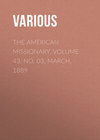Czytaj książkę: «The Atlantic Monthly, Volume 18, No. 106, August, 1866»
HOW MY NEW ACQUAINTANCES SPIN
The strictly professional man may have overcome his natural aversion to some of the most interesting objects of his study, such as snakes, and toads, and spiders, and vermin of all kinds; but people in general have always required that any attempt to force such abominations upon their notice should be preceded by a more or less elaborate and humble acknowledgment of their hideous aspect, their ferocious disposition, their dark and bloody deeds, and the utter impossibility of their conducing in any way to human comfort and convenience.
But, while admitting the truth of much that has been thus urged against spiders as a class, I must decline, or at least defer, conforming to custom in speaking of the particular variety which we are about to consider, and I believe that it will need only a glance at the insect and its silk, and a brief notice of its habits, to justify my indisposition to follow the usual routine.
Without apology, then, I shall endeavor to show that in the structure, the habits, the mode of growth, and, above all, in the productions of this spider are to be found subjects worthy the attention of every class of minds; for to the naturalist is exhibited a species which, though not absolutely new to science, was never seen nor heard of by Professor Agassiz till the spring of 1865, and which is so narrowly circumscribed in its geographical distribution that, so far as I can ascertain, it was never observed by Hentz,—a Southern entomologist, who devoted himself particularly to spiders,—and is met with only upon a few low, marshy islands on the coast of South Carolina, and perhaps of other Southern States. Its habits, too, are so interesting, and so different in many respects from those recorded of other species, that the observer of living creatures has here an abundant opportunity, not only for increasing his own knowledge, but for enlarging the domain of science. And this more especially in America; for while, in England, Blackwall and others have been laboring for more than thirty years, spiders seem to have received little attention on this side of the Atlantic.
We have now, moreover, in our observation of these insects, an incentive of sovereign effect, namely, the hope of increasing our national wealth; for to the practical man, to the manufacturer and the mechanic, is offered a new silken material which far surpasses in beauty and elegance that of the silk-worm, and which, however small in quantity at present, demands some attention in view of the alarming decrease in the silk crops of Europe. This material is obtained in a manner entirely new,—not, as with the worm, by unwinding the cocoons, nor yet, as might be suggested for the spider, by unravelling the web, but by drawing or winding or reeling directly from the body of the living insect, even as you would milk a cow, or, more aptly, as wire is pulled through a wire-drawing machine.
To the admirer of the beautiful and perfect in nature is presented a fibre of absolute smoothness, roundness, and finish, the colors of which resemble, and in the sunlight even excel in brilliancy those of the two precious metals, silver and gold; while the moralist who loves to illustrate the workings of God's providence in bringing forth good out of evil, by comparing the disgusting silk-worm with its beautiful and useful product, may now enforce the lesson by the still more striking contrast between this silk and the loathed and hated spider.
The statesman who, after a four years' war, sees few indications of a better spirit on the part of the South, and is almost ready to exclaim, "Can any good thing come out of Nazareth?" may now perhaps discern a spot, small indeed, but brilliant, on the very edge of the dark Carolina cloud; and it may not be too much to hope that, in course of time, the cords of our spider's golden and silver silk may prove potent bonds of union with the first of the rebellious States.
As to the mathematician who believes in the inborn tendency of mankind to variation and imperfection, and holds up to us, as shining examples of mathematical accuracy, the work of certain insects, and who—since Professor Wyman has shown that the hexagonal form of the bee's cell is not of original design, but rather the necessary result of difficulties met and overcome in the most economical manner, though by no means always with perfect exactness and uniformity—has fallen back upon the ancient and still prevalent belief in the precise construction of the spider's web, (which, as will be seen, really displays it no more than does the bee's cell,)—to this disappointed man of geometry and figures is now offered the alternative of either finding a new and truer illustration, or of abandoning his position entirely.
Let us, then, wait till we have seen this spider and heard his story. His story! That reminds me of another class which may possibly be represented among my readers, and whose members, in the contemplation of the domestic economy of these insects, will, I fear, discover many and weighty arguments in favor of the various opinions entertained by the advocates of Woman's Rights; for here is a community in which the females not only far exceed the males in number, but present so great a contrast to them in size and importance, that, but for absolute proof, they never would be regarded as belonging to the same species.
Here, then, is a life-size picture of our spider and of—I was about to say, his partner; but in truth it is she who is the spider, and he is only her partner. Such is the real physical, and, so to speak, mental superiority of the female, that, even if we insist upon the legal equality at least of the masculine element, we can do so only in name, and will find it hard to avoid speaking of him as the male of the Nephila plumipes, thus tacitly admitting her as the truer representative of the species. Their relative size and appearance are shown by the figures; but it may be added that she is very handsome; the fore part of her body, which, being composed of the head and chest soldered together, is termed cephalothorax, is glossy-black and covered, except in spots, with white hairs; she has also upon six of her legs one or two brushes of black hairs;—while he is an insignificant-looking insect of a dull-brown color and half-starved look, with only a few scattered bristles upon his slender limbs. He does nothing for himself, leaving her to make the web and provide the food, and even to carry him on her back when removal is necessary; but she makes up for the imposition by keeping him on short allowance and at a respectful distance, excepting when the impregnation of her eggs is necessary; and even then she is mistress of the situation, and, etiam in amoribus sæva, may afterward eat him up. But of this contrast between the two sexes, of their functions and their relations to each other, more hereafter. It is sufficient to observe that, when this spider is mentioned, and the sex is not specified, the female is always referred to.

Fig. 1. Male and Female Nephila plumipes.
When, where, and how was this spider discovered? and why is it that we have never heard of it before? To answer these questions, we must go back three years, to the 19th of August, 1863, and to the camp of the Fifty-fifth Regiment of Massachusetts Volunteers, on a desolate island a little south from the harbor of Charleston, South Carolina, and in sight of the fortress which Gillmore had just begun to strengthen by the addition of tons of Union shot and shell, till, from tolerably strong masonry, its walls became solid earthworks which nothing could pierce or greatly injure. There, at the north end of Folly Island,—scarce wider than our camp at that point, and narrower than the magnificent beach which, at low tide, afforded ample space for the battalion drill,—I found in a tree a very large and handsome spider, whose web was at least three feet in diameter.
Glad enough to meet with anything new, and bearing in mind the interest with which, when a boy, I had watched and recorded the operations of our common house and hunting spiders, I entangled him—I didn't then know it was her, so let it pass—in the web, and carried it to my tent. The insect was very quiet, and did not attempt to escape; but presently, after crawling slowly along my sleeve, she let herself down to the floor, taking first the precaution, after the prudent fashion of most spiders, to attach to the point she left a silken line, which, as she descended, came from her body. Rather than seize the insect itself, I caught the thread and pulled. The spider was not moved, but the line readily drew out, and, being wound upon my hands, seemed so strong that I attached the end to a little quill, and, having placed the spider upon the side of the tent, lay down on my couch and turned the quill between my fingers at such a rate that in one minute six feet of silk were wound upon it. At the end of an hour and a half I estimated, with due allowance for stop-pages, that I had four hundred and fifty feet, or one hundred and fifty yards, of the most brilliant and beautiful golden silk I had ever seen.
During all this operation the spider had remained perfectly quiet, but finally put an end to my proceedings by grasping the line with the tip of one of her hind legs so that it snapped. I was tired, however, and contented myself with the quantity already obtained, which now formed a raised band of gold upon the quill. This specimen is now in my possession, but has been removed from the quill to ascertain its weight, which is one third of a grain.
It is worthy of notice, perhaps, that in all this was involved no new fact, but only a happy deduction from one known ages ago; namely, that a spider, when dropping, leaves her line attached, and so allows it to be drawn from her body. Nothing was more natural than to simply reverse the position of the fixed point, and, instead of letting the spider go away from the end of her line, to take the end of her line away from her. So natural, indeed, did it seem, that my gratification at having been (as was then supposed) the first to do it was, on reflection, mixed with surprise that no one had ever thought of it before, and I am very glad to find that at least four individuals have, within the last century, pulled silk out of a spider, though of these only one, whose researches I hope to make known, regarded the matter as anything more than a curious experiment.
I had never before seen such a spider, nor even paid attention to any geometrical species; though one large black and yellow variety is, or used to be, common enough in our fields at the North. Neither had I ever heard of such a method of obtaining silk. But though my first specimen was not preserved, and a second was never seen on Folly Island, yet I was so impressed with its size and brilliant colors, and especially with the curious brushes of black hairs on its legs, that when, during the following summer, another officer described to me a great spider which was very common on Long Island, where he was stationed, I knew it was the same, and told him what I had done the year before, adding that I was sure something would come of it in time.
With leisure and many spiders at his command, this officer improved upon my suggestion, by substituting for my quill turned in the fingers a wooden cylinder worked by a crank, and by securing, at a proper distance, (between pins, I think,) one or more spiders, whose threads were guided between pins upon the cylinder. He thus produced more of the silk, winding it upon rings of hard rubber so as to make very pretty ornaments. With this simple machine I wound the silk in two grooves cut on a ring of hard rubber and parallel except at one point, where they crossed so as to form a kind of signet. Another officer now suggested and put in operation still another improvement, in the shape of the "gear-drill-stock" of our armorer's chest. This, being a machine for drilling iron, was rough in its construction and uneven in its action, but, having cog-wheels, a rapid and nearly steady motion could be given to its shaft. To this shaft he attached a little cross of rubber, and covered it with silk, which was of a silver-white color instead of golden-yellow, as in other cases. The difference in color was then supposed to depend upon individual peculiarities, but the true explanation will be given farther on. With this gear-drill-stock, upon a larger ring, one inch in diameter and three eighths of an inch in width, in a groove upon its periphery one fourth of an inch in width, and across the sides of the ring in two directions, I wound three thousand four hundred and eighty-four yards, or nearly two miles, of silk. The length was estimated by accurately determining the different dimensions of the ring where wound upon, and multiplying by this the number of revolutions of the cylinder per minute (170), and this product again by the number of minutes of actual winding (285), deducting from the gross time of winding (about nine hours) each moment of stoppage for any cause.
This was late in the fall of 1864, and, our specimens being sent home, further experiments, and even thoughts upon the subject, were prevented by the expedition against the Charleston and Savannah Railroad, and the many changes of station that followed the disastrous battle of Honey Hill. But, when I was at the North in February, 1865, a friend expressed to me his confident belief that this new silken product could be made of practical utility, and advised me to make inquiries on the subject. So, before presenting it to the scientific societies, I tested the strength of the silk by attaching to a fixed point one end of a thread one four-thousandth of an inch in diameter, and tying the other end upon the arm of an accurate balance: weights were then dropped in to the amount of fifty-four grains before the line was broken. By a calculation from this, a solid bar of spider's silk, one inch in diameter, would sustain a weight of more than seventy tons; while a similar bar of steel will sustain only fifty-six, and one of iron twenty-eight tons. The specimens were then exhibited to Professors Wyman, Agassiz, and Cooke, of Harvard University, to all of whom the species of spider was unknown, though Professor Wyman has since found a single specimen among some insects collected at the South; while to them as well as to the silk-manufacturers the idea of reeling silk directly from a living insect was entirely new. The latter, of course, wished to see a quantity of it before pronouncing upon its usefulness. So most of my furlough was spent in making arrangements for securing a number of the spiders, and reeling their silk during the coming summer. These comprised six light wooden boxes with sliding fronts, each eighteen inches wide and high and one foot deep, and containing six tin trays one above another, each of which, again, held twenty-four square paper boxes two and a half inches in diameter, and with lids closed by an elastic. Into these the spiders were to be put for transportation. Then I had made a costly machine for reeling the silk, which, however, proved of no practical value.
In March, with these and other real or fancied adjuvants, (some of which proved even less useful and trustworthy than the machine,) but, above all, with a determination to put this matter to the test of actual experiment, I rejoined the regiment at Charleston, which had just fallen into our hands. It was not until April, however, that we were so situated that I could make any attempt to get spiders. Of course it was not expected that the full-grown ones should be found at that season, but the eggs or young should be abundant where the spiders had been in the summer.
Before recounting my adventures in pursuit of my spinster friends, it may be well to say a few words of the locality which they inhabited.

Fig. 2. Map of Charleston and Vicinity.
Charleston stands upon the extremity of a narrow peninsula, between the Cooper and the Ashley Rivers. Charleston Harbor, supplied by these and some smaller streams, lies between Mt. Pleasant and Sullivan's Island on the northeast, and James and Morris Islands on the southwest. One cannot but be struck with the resemblance, so great as to be almost symmetrical, between the two sides of the harbor. Mt. Pleasant and James Island are quite high land,—high at least for the coast of South Carolina,—and are separated from the mainland, the one by the Wando River, the other by Wappoo Creek; while Sullivan's Island, where stand Fort Moultrie and other Rebel batteries, corresponds almost precisely to Morris Island, both being low and sandy, and being, as it were, bent inland from the sea, with sharp points looking toward the city, their convex shores forming a rounded entrance to the harbor. Extending southward from Morris Island, and separated from it by Lighthouse Inlet, is Folly Island; and in exact correspondence to the latter, north of Sullivan's Island, and separated from it by Breach Inlet, is a similar sand-ridge called Long Island. But now occurs a difference; for while between Long and Sullivan's Islands and Christ's Church Parish is an immense salt marsh intersected by creeks, but presenting an unbroken surface, in the midst of the corresponding marsh between Morris and Folly Islands and James Island is a group of low wooded islands, the largest of which lies opposite the upper or north end of Folly Island. To this no name is given on the maps, nor is it even distinguished from the marsh. It is, however, completely surrounded by water; and, though this is in the form of creeks neither wide nor deep, yet the peculiar softness of the mud, and the absence of any landing-place except upon the side toward Folly Island, render it almost inaccessible.
To this narrow strip of land, not three miles in length, was given the name of Long Island,—perhaps by our own troops, who knew nothing of an island of the same name north of the harbor; and in case it is found that no other name belongs to it, we may properly avoid a confusion, and christen it Spider Island, in honor of the remarkable insects for whose especial benefit it seems to have been made, and which, with the exception of the mosquitoes, are its sole inhabitants.
As was said, the first spider was found on Folly Island on the 19th of August, 1863: it was also the last there seen. During the summer of 1864, many were found on Long Island (so called); and when, in the spring of 1865, our regiment was encamped on James Island near Wappoo Creek, it was toward Long Island that all my attention, so far as concerned spiders, was directed.
But first, as a bit of collateral history, and to show how easily and how far one may go astray when one of the links in the chain of argument is only an inference, let me relate that, while riding over James Island, I observed upon trees and bushes numbers of small brown bags, from half an inch to an inch and a half in diameter, pear-shaped, and suspended by strong silken cords. The bags themselves were made of a finer silk so closely woven as to resemble brown paper, and, when opened, were found to contain a mass of loose silk filled with young spiders to the number of five hundred or more. In certain localities, especially in a swampy field just outside the first line of Rebel works, they were quite abundant. I had soon collected about four hundred of them, which, by a moderate estimate, contained two hundred thousand little spiders,—quite enough, I thought, with which to commence operations. But one hot day in June I placed them all on a tray in the sun. I was called away, and on my return found my one fifth of a million young spiders dead,—baked to death.
Prior to this catastrophe, however, I had become convinced that these were not the spiders I sought. Indeed, my only reasons for thinking they might be were, first, the abundance of these cocoons in a locality so near Long Island; and, second, my own great desire that they should prove the spiders I wanted. The young spiders, it is true, did not at all resemble their supposed progenitors, as to either shape, or color, or markings; yet all of these evidently changed during growth, and would not of themselves disprove the relationship.
One day in April, however, a cocoon was found in a tree on James Island, of a very different appearance from the others. It was of loose texture, and, instead of being pear-shaped, was hemispherical in form, and attached by its flat surface to the lower side of a leaf. This also contained young spiders, a little larger and a little brighter in color than the others, but really bearing no resemblance to the full-grown spiders of Long Island. This single cocoon formed the entering wedge of doubt, and soon it was clear that the only means of proof lay on Long Island itself.
But how was this to be reached? Easily enough while we were upon Folly Island and could row through the creeks to a wharf on the east side of Long Island. But now the case was altered; for between James and Long Islands was the immense marsh already mentioned, intersected by creeks, and composed of mud practically without bottom, and ranging from eighteen to twenty-three feet in depth by actual measurement. Around or over or through this marsh it was necessary to go, in order to reach Long Island, the home of the spiders.
I could easily occupy the rest of my allotted space in recounting my various attempts to reach this El Dorado, which my fancy, excited by every delay, stocked with innumerable cocoons of the kind already found so abundantly on James Island. These I expected would furnish thousands of spiders, the care of which, with the reeling of their silk, would give employment to all the freed people in South Carolina,—for even then the poor creatures were finding their way to the coast. And perhaps, I thought, some day, the Sea-Island silk may be as famous as the choice Sea-Island cotton. This hope I still cherish, together with the belief that, under certain conditions, the spiders may also be reared at the North.
After riding miles and miles in all directions in search of the readiest point of attack; after having once engaged a row-boat to go around through Stono River and meet me at the nearest point of land,—on which occasion I dismounted to give my horse a better chance of getting over a bad place in the road, and the ungrateful beast left me in the lurch and went home much faster than he came, while I, being now half-way, walked on through the marsh, and had the pleasure of sitting on a log in a pouring rain for an hour, with Long Island just on the other side of a creek over which no boat came to carry me,—after this and other disappointments, I at last made sure by going in the boat myself, and so finally reached the island. But now, to my discomfiture, after a most careful search, I saw only two or three cocoons of the kind I looked for, while the others, of loose texture, were quite abundant, and doubtless would have been found in still greater numbers but for their always being under leaves, and often at a considerable height. It was probable now that these latter cocoons contained the spiders, and that the former were a different species.
The regiment now removed to the interior of the State, and while there occurred the coup de soleil above mentioned. We remained at Orangeburg until the middle of August, and then, being stationed at Mt. Pleasant, I again made raids for spiders. Upon James Island, in the localities where during the spring the cocoons were abundant, I found many large geometrical spiders, all of one kind, but not of the kind I sought. They were bad-tempered, and their legs were so short and strong that it was not easy to handle them, while their silk was of a light, and not brilliant, yellow.
My first attempt upon Long Island was made by leaving Charleston in a boat, which, after touching at Sumter, landed me at Fort Johnson. Here I was joined by a sergeant and corporal of the Fifty-fourth Massachusetts, and we walked across to a little settlement of freed people not far from Secessionville, where a boat and crew were engaged. It would be tedious to relate how, after sticking on invisible oyster-beds and mud-flats, and losing our way among the creeks, at two o'clock we found ourselves about one hundred yards from the north end of the island; and how, since it was too late to try to reach the wharf on the east side, even had we been sure of the way, the two Fifty-fourth boys and myself got out of the boat and essayed to cross upon the marsh. Such a marsh! We have marshes at the North, but they are as dry land in comparison. I had seen them at the South, had stepped upon and into them, but never one like this. It was clear mud, as soft as mud could be and not run like the water that covered it at high tide. Even the tall rushes wore an unsteady look; and the few oysters upon its surface evidently required all their balancing powers to lie upon their flat sides and avoid sinking edgewise into the oozy depths. In we sank, over ankles, at the first step, and deeper and deeper till we took a second; for our only safety lay in pushing down the rushes with the inside of one foot and treading upon them, till the other could be withdrawn from its yielding bed, and a spot selected for the next step forward. I say selected, for even this mud was more firm than a hole in it filled with water and treacherously concealed by a few rushes. A misstep into one of these pitfalls brought me to my knees, and well-nigh compelled me to call for help; but a sudden and determined spring, and a friendly bunch of rushes beyond, spared me that mortification. When two thirds of the way across, and while thinking we should soon reach dry land, we came upon the edge of a creek, not wide, it is true, but with soft, slimy, sloping sides, (for banks they could not properly be called,) and no one knew how many feet of mud beneath its sluggish stream. Under ordinary circumstances I might have sounded a retreat; but, remembering that there was twice as much mud behind as before us, and feeling ourselves sinking slowly but surely in our tracks, we slid down the sides into the water. This received our bodies to the waist, the mud our legs to the knees; but we struggled through, and, after another terrible thirty yards of mud, reached Long Island. Leaving my faithful companions to rest, I struck off down the east side of the island, and soon found spiders in plenty. Stopping at the wharf, and returning upon the west side, I counted one hundred spiders in less than an hour. This was only a voyage of discovery, but I could not resist the temptation to capture one big fellow and put it in my hat, which, with the edges brought together, I was forced to carry in my teeth, for one hand was required to break down the webs stretched across my path, and the other to do battle in vain with the thousands of mosquitoes, of huge size and bloody intent, besetting me on every side. What with the extreme heat and my previous fatigue, and the dread lest my captive should escape and revenge herself upon my face while I was avoiding the nets of her friends, and the relentless attacks of their smaller but more venomous associates, it was the most uncomfortable walk imaginable. To complete my misery, the path led me out upon the marsh where I could see nothing of the boat or my companions, and whence, to reach them, I had to walk across the head of the island. Excepting the dreaded recrossing of the mud, I hardly remember how we made our way back; but by one means and another I finally reached Charleston at nine o'clock, about as disreputable-looking a medical man as ever was seen.
However, all this was soon forgotten, and, being now assured of the presence of the spiders in their former haunts, on the 30th of August, 1865, I organized a new expedition, which was to proceed entirely by water, and which consisted of a sail-boat and crew of picked volunteers. Leaving Mt. Pleasant in the morning, we crossed the harbor, and were soon lost in the meanderings of the creeks behind Morris Island. Lost is appropriate, for, once in these creeks, you know nothing, you see and hear nothing, and, if you change your course, must do so by mere guess. But the most annoying thing is, after an apparent advance of a quarter of a mile, to find yourself not twenty yards from your starting-point, so tortuous are the windings of the creeks.
By dint of hard rowing (in the wrong direction, as we soon found), then by walking across Morris Island to Light-House Inlet, and still harder rowing from there to the wharf of Long Island, we succeeded in securing sixty spiders; but now arose a furious storm of wind and rain, which not only compelled our retreat, but drenched us to the skin, blew us back faster than we could row, and threatened to overturn our boat if we hoisted the sail; so slow was our progress, that it was eleven o'clock at night before we reached Mt. Pleasant. Thus ended my last and only successful raid upon Long Island.
It may seem that I have dwelt longer than was necessary upon the circumstances attending the discovery of this spider and its silk. If so, it is not merely because at that time both were new to myself and all to whom I showed them, and everything concerning them was likely to be impressed upon my mind, but also because I then hoped that the idea of obtaining silk directly from a living insect might be found of practical importance, as I still hope it may. The incidents illustrate, too, the nature of the obstacles daily encountered and overcome by our troops; for no one who has never seen or stepped into a Sea-Island marsh can realize how difficult it was for our forces to obtain a foothold in the vicinity of Charleston. This was appreciated by the old freedman whom we left in the boat while crossing the mud. "No wonder," he said, "the Yankees whipped the Rebels, if they will do such things for to catch spiders."



















